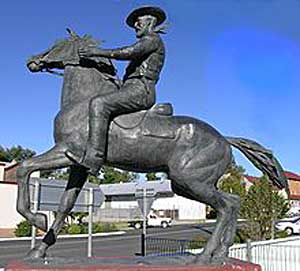| Frederick Ward - Captain Thunderbolt | |
|---|---|
| Known as 'The Gentleman Bushranger', he was among the longest operating bushrangers until his death. | |
Michael Ward arrived in Australia aboard the transport ship 'Indefatigable' in April, 1815 after being convicted
of possession of stolen liquor and sentenced to death, later communted to transportation. Married to Sophia with
a daughter of the same name, she followed him to Sydney in July 1815 as a free woman and successfully petitioned
for his release due to her harsh circumstances and he was released under 'Ticket of Leave' to reside with her at
Windsor, north east of Sydney. Records show that in 1822 they lived, with Sophia, Sarah, Edward and Amelia on a
leasehold property there and tended 13 hogs and grew maize. He received a Colonial pardon in 1834 and the family
moved to Maitland on the Hunter River. |  Statue of Thunderbolt at Uralla |
|
Frederick Wordsworth Ward (1835 - 25 May 1870), better known as Captain Thunderbolt, was
an Australian bushranger renowned for escaping from Cockatoo Island, and also for his reputation
as the "gentleman bushranger" and being the longest roaming bushranger in Australian history. He began his working career at the tender age of 11 in 1846 as a general hand on 'Aberbaldie' Station near Walcha working with horses and doing other odd jobs around the station. He moved on fairly quickly and over the next decade found work at many stations in the area, gaining a reputation as a horseman and at one stage was employed on the famed horse stud 'Tocal' where he became a noted horse-breaker, a skill much valued in those times. Times were tough in the new colonies and stories abounded of rustling, robberies, bushrangers and easy money. In 1856 his nephew, John Garbutt, headed a large horse and cattle stealing operation, and invited other members of the extended Ward family to join him. Frederick helped drive some four dozen stolen horses from the Lambs Valley property of his brother William to Windsor where they were sold at auction. Frederick and his nephews John and James Garbutt were caught and convicted, the Garbutts of horse-stealing and Frederick of receiving horses knowing them to be stolen. Sentenced to ten years hard labour they were all sent to Cockatoo Island penal establishment to serve their sentences. They were released after serving four years of their time and settled near Mudgee under ticket-of-leave regulations. It was here John Garbutt met and married Elizabeth Blackman, a wealthy widow and owner of Cooyal Inn and station. Fred worked for them and met a married woman, Mary Ann Bugg, with whom he started a relationship, eventually getting her pregnant. The couple decided to go to her father's farm at Monkerai near Dungog where Mary would have the child and, against the conditions of his ticket-of-leave, the overstayed the three month muster limit and was arrested upon his return to Cooyal. His ticket-of-leave was revoked and he was sent back to Cockatoo Island to serve out the remainder of his 10 year sentence. He was also accused of riding a 'stolen' horse. Although there was no direct proof of this, he received an additional 3 years for the 'crime'. Bitter now, Frederick and another convict, Frederick Bittern hid from a work gang on 11th September, 1863 and swam to the shore to escape. Now escapees they headed for Uralla in the New England region to take up bushranging, beginning by robbing a shepherd's hut on the 24th of October. A few days later they were lying in wait for the mail escort near 'Big Rock' (now Thunderbolt's Rock) when they were spotted by troopers and Ward was wounded in a gunbattle which left him with a notable scar behind his left knee. They escaped and split a couple of weeks later. It was around this time in December after a toll robbery at Rutherford that Ward adopted the pseudomym Captain Thunderbolt. He turned his hand now to full time bushranging across northern New South Wales operating as far north as Queensland and as far west as Bourke. His notoriety grew as he held up hotels, inns, stations, mail escorts and general travellers until he was shot and killed in May 1870 by Constable Alexander Walker after a robbery near Uralla. During these years he was joined occasionally by other like minded gang members including John Thompson who was shot and captured near Moree; Jemmy the Whisperer who shot and killed a policeman in 1865; Thomas Mason in 1867 and William Monckton in 1868. Life was becoming more dangerous as time passed and when Monckton and he parted, Frederick eased down his activities for a year or two only occasionally showing himself to commit a robbery until in May 1870 he made the fateful decision to rob travellers near 'Big Rock' and fell foul of Constable Walker. Legend has it he had spent quite a bit of time in the nearby Royal Oak Tavern prior to the confrontation and was affected by alcohol. The publican's wife, Eliza Blanch warned him to get away as the police were nearby, but he ignored the warning. Crowds flocked to see the body of the notorious bushanger and a generous sum was raised in appreciation of Constable Walker. There is a statue of Thunderbolt at the junction of the New England Hwy and the scenic Thunderbolt's Way, a drive between Gloucester and Inverell, which bears his name at Uralla. More about him will be found at McCrossin's Mill Museum in Uralla which includes a series of 9 paintings by Phillip Pomroy. Thunderbolt died unaware his relationship with Mary Ann Bugg resulted in the birth of his namesake in August 1868. Frederick Wordsworth Ward Jnr became a groom and later a horse-trainer, and died unmarried as Frederick Wordsworth Burrows in 1937. | |
|
Pete Wilkins | |
